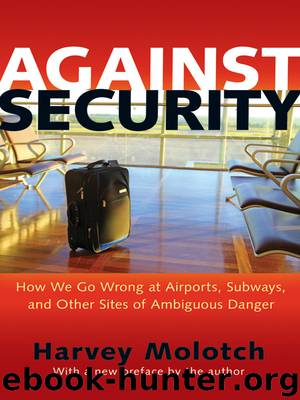Against Security by Molotch Harvey

Author:Molotch, Harvey
Language: eng
Format: epub
Publisher: Princeton University Press
Published: 2014-03-14T16:00:00+00:00
DESIGN RISES
Well before the dust began clearing, schemes began to unfold as to what, specifically, to build. Leaving the site open with a meadow for peaceful repose got a mention. The notion of a quiet sort of monument, one that might leave standing some of the shards of the prior structure, also surfaced. Several twisted steel arches from the lower floors had survived both the buildings’ collapse and initial clearance efforts. They were indeed poetically evocative, in the manner of a sadly splendid ruin. Precedents for retaining bomb remains do exist, as in the Kaiser Wilhelm Memorial Church (“the hollow tooth”) in Berlin’s bustling center. The German authorities left the bombed-out remains to stand as a reminder of war-making horrors as well as of defeat. Indeed, much of German reconstruction, including the development of Bonn as the new capital, was done with understatement and humility to deliberately contrast with fascist bellicosity.17 Similarly, at the Hiroshima Peace Memorial, a bombed-out dome remains in place. Both such memorials connote contrition and a renunciation of political violence. It is also true that the decisions to retain were both made while the respective countries were under U.S. occupation. But such a mode of memorialization would not do as precedent for post-9/11 commemoration.
In terms of the commercial real estate market, the most reasonable use of the property would have been for residential apartments, as advocated by the New Yorker architectural critic, Paul Goldberger.18 The area’s excellent subway access (the best service for any New York neighborhood) and its location at a stone’s throw from waterfront park-land on three sides make it a highly desirable place to live. Finance had been, for about the previous twenty years, migrating in any event from the so-called Financial District to midtown. Back-office functions were moving to Brooklyn and New Jersey, a trend accelerated by the attacks. In effect—an awkward truth—the downtown devastation further rationalized land-use change as financial firms took the opportunity and gained the experience of being in places more suited to their activities—something predicted by the then-head of New York Chamber of Commerce, Kathryn Wylde.19 In the wake of vacancies that began well before 9/11, developers were converting downtown office buildings into residential condominiums and rental apartments. The area, a.k.a. the “Financial District,” received its residential real estate advert imprimatur “FiDi.”
Partly to reverse the financial out-migration, there had been the goal, indeed, made explicit in post-9/11 redevelopment documents, to construct a “one-seat” mass transit line from downtown to JFK Airport—one-seat meaning no need to transfer from one train or bus to another as now required. This would finally give city users a way to their flights in a fast and comfortable way (thirty-six minutes from Lower Manhattan). But such a utilitarian type of public infrastructure did not sustain interest. It lacked the kind of glamour and excitement of a soaring tower and would, it must be acknowledged, have been expensive—about $4 billion. But that is within range of construction costs of, for example, a dramatic new subway and New Jersey commuter train terminal designed by Santiago Calatrava being built at the site.
Download
This site does not store any files on its server. We only index and link to content provided by other sites. Please contact the content providers to delete copyright contents if any and email us, we'll remove relevant links or contents immediately.
Cecilia; Or, Memoirs of an Heiress — Volume 1 by Fanny Burney(31332)
Cecilia; Or, Memoirs of an Heiress — Volume 3 by Fanny Burney(30934)
Cecilia; Or, Memoirs of an Heiress — Volume 2 by Fanny Burney(30889)
The Great Music City by Andrea Baker(21313)
We're Going to Need More Wine by Gabrielle Union(18072)
Bombshells: Glamour Girls of a Lifetime by Sullivan Steve(13108)
Pimp by Iceberg Slim(12931)
All the Missing Girls by Megan Miranda(12747)
Fifty Shades Freed by E L James(12451)
Norse Mythology by Gaiman Neil(11883)
Talking to Strangers by Malcolm Gladwell(11876)
Crazy Rich Asians by Kevin Kwan(8349)
Mindhunter: Inside the FBI's Elite Serial Crime Unit by John E. Douglas & Mark Olshaker(7834)
The Lost Art of Listening by Michael P. Nichols(6472)
Enlightenment Now: The Case for Reason, Science, Humanism, and Progress by Steven Pinker(6405)
Bad Blood by John Carreyrou(5769)
The Four Agreements by Don Miguel Ruiz(5510)
Weapons of Math Destruction by Cathy O'Neil(5036)
We Need to Talk by Celeste Headlee(4868)
